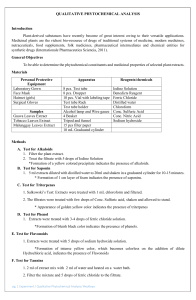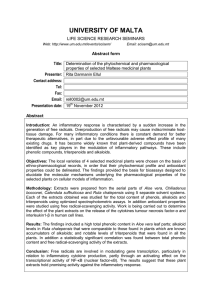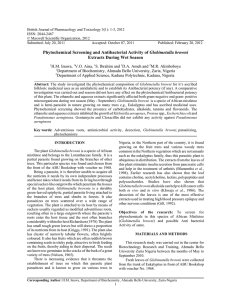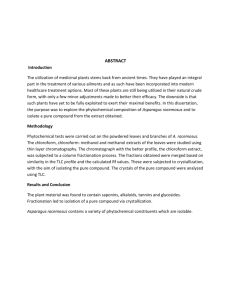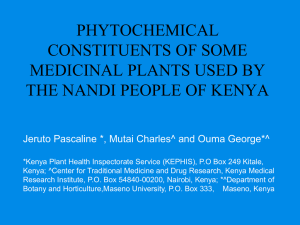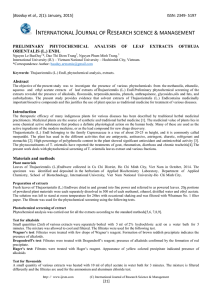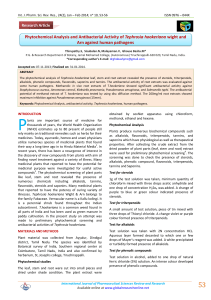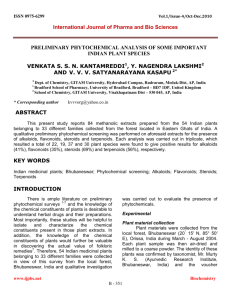Document 13309649
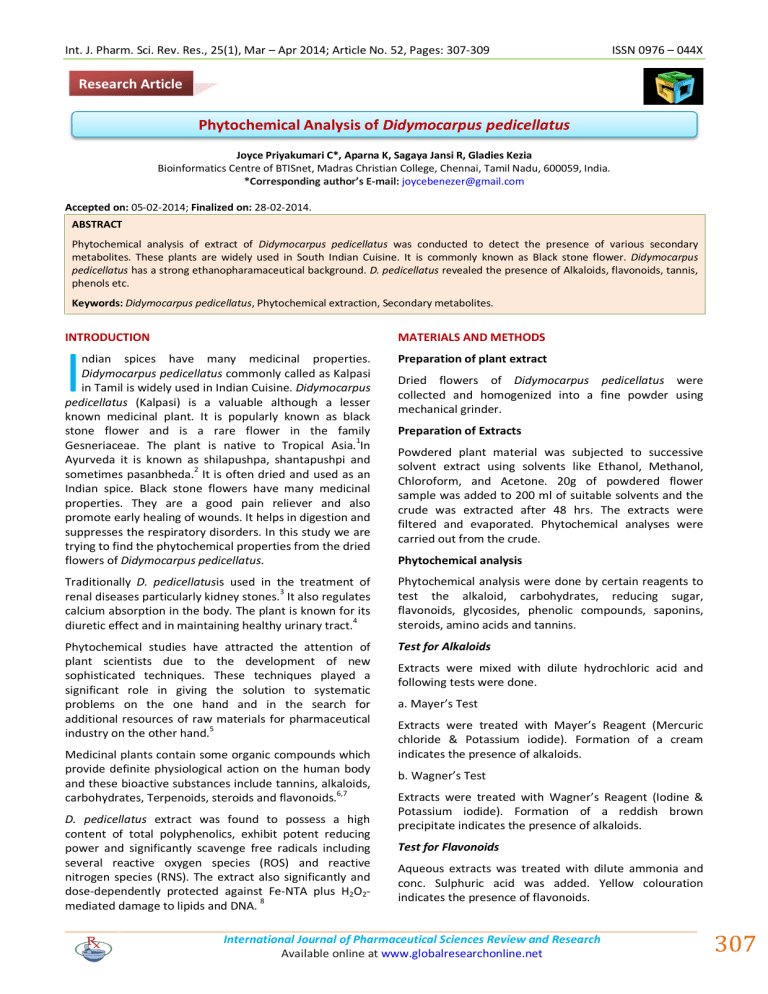
Int. J. Pharm. Sci. Rev. Res., 25(1), Mar – Apr 2014; Article No. 52, Pages: 307-309 ISSN 0976 – 044X
Research Article
Phytochemical Analysis of Didymocarpus pedicellatus
Joyce Priyakumari C*, Aparna K, Sagaya Jansi R, Gladies Kezia
Bioinformatics Centre of BTISnet, Madras Christian College, Chennai, Tamil Nadu, 600059, India.
*Corresponding author’s E-mail: joycebenezer@gmail.com
Accepted on: 05-02-2014; Finalized on: 28-02-2014.
ABSTRACT
Phytochemical analysis of extract of Didymocarpus pedicellatus was conducted to detect the presence of various secondary metabolites. These plants are widely used in South Indian Cuisine. It is commonly known as Black stone flower. Didymocarpus
pedicellatus has a strong ethanopharamaceutical background. D. pedicellatus revealed the presence of Alkaloids, flavonoids, tannis, phenols etc.
Keywords: Didymocarpus pedicellatus, Phytochemical extraction, Secondary metabolites.
INTRODUCTION
I ndian spices have many medicinal properties.
Didymocarpus pedicellatus commonly called as Kalpasi in Tamil is widely used in Indian Cuisine. Didymocarpus
pedicellatus (Kalpasi) is a valuable although a lesser known medicinal plant. It is popularly known as black stone flower and is a rare flower in the family
Gesneriaceae. The plant is native to Tropical Asia.
1
In
Ayurveda it is known as shilapushpa, shantapushpi and sometimes pasanbheda.
2
It is often dried and used as an
Indian spice. Black stone flowers have many medicinal properties. They are a good pain reliever and also promote early healing of wounds. It helps in digestion and suppresses the respiratory disorders. In this study we are trying to find the phytochemical properties from the dried flowers of Didymocarpus pedicellatus.
MATERIALS AND METHODS
Preparation of plant extract
Dried flowers of Didymocarpus pedicellatus were collected and homogenized into a fine powder using mechanical grinder.
Preparation of Extracts
Powdered plant material was subjected to successive solvent extract using solvents like Ethanol, Methanol,
Chloroform, and Acetone. 20g of powdered flower sample was added to 200 ml of suitable solvents and the crude was extracted after 48 hrs. The extracts were filtered and evaporated. Phytochemical analyses were carried out from the crude.
Phytochemical analysis
Phytochemical analysis were done by certain reagents to test the alkaloid, carbohydrates, reducing sugar, flavonoids, glycosides, phenolic compounds, saponins, steroids, amino acids and tannins.
Test for Alkaloids
Traditionally D. pedicellatusis used in the treatment of renal diseases particularly kidney stones.
3
It also regulates calcium absorption in the body. The plant is known for its diuretic effect and in maintaining healthy urinary tract.
4
Phytochemical studies have attracted the attention of plant scientists due to the development of new sophisticated techniques. These techniques played a significant role in giving the solution to systematic problems on the one hand and in the search for additional resources of raw materials for pharmaceutical industry on the other hand.
5
Medicinal plants contain some organic compounds which provide definite physiological action on the human body and these bioactive substances include tannins, alkaloids, carbohydrates, Terpenoids, steroids and flavonoids.
6,7
D. pedicellatus extract was found to possess a high content of total polyphenolics, exhibit potent reducing power and significantly scavenge free radicals including several reactive oxygen species (ROS) and reactive nitrogen species (RNS). The extract also significantly and dose-dependently protected against Fe-NTA plus H
2
O
2
mediated damage to lipids and DNA.
8
Extracts were mixed with dilute hydrochloric acid and following tests were done. a. Mayer’s Test
Extracts were treated with Mayer’s Reagent (Mercuric chloride & Potassium iodide). Formation of a cream indicates the presence of alkaloids. b. Wagner’s Test
Extracts were treated with Wagner’s Reagent (Iodine &
Potassium iodide). Formation of a reddish brown precipitate indicates the presence of alkaloids.
Test for Flavonoids
Aqueous extracts was treated with dilute ammonia and conc. Sulphuric acid was added. Yellow colouration indicates the presence of flavonoids.
307 International Journal of Pharmaceutical Sciences Review and Research
Available online at www.globalresearchonline.net
Int. J. Pharm. Sci. Rev. Res., 25(1), Mar – Apr 2014; Article No. 52, Pages: 307-309 ISSN 0976 – 044X
Test for Terpenoids
To the extracts 2ml of chloroform was added, conc.
Sulphuric acid was carefully added to form a layer.
Reddish brown colouration at the interface indicates the presence of terpenoids.
Test for Steroids a. Extracts were mixed with 2ml of chloroform and conc.sulphuric acid was added sideways. A red colour producing at the lower chloroform layer indicate the presence of steroids. b. Extracts were mixed with 2ml of chloroform, 2 ml of conc.sulphuric acid and 2ml of acetic acid were poured into the mixture. Development of greenish colouration indicates the presence of steroid.
Test for Phenols
Ferric chloride Test
Extracts were treated with 3 to 4 drops of ferric chloride solution. Formation of bluish black colour indicates the presence of phenol.
Test for Glycosides a. Libermann Burchard’s Test
Extracts were treated with 2 ml of chloroform and 2 ml of acetic acid. The mixture was cooled in ice and conc.
Sulphuric acid was added. Colour change from violet to blue to green the indicates the presence of glycosides b. Salkowski’s Test
Extracts were mixed with 2ml of chloroform. Then 2 ml of conc. Sulphuric acid was added carefully and shaken gently. A reddish brown colour indicates the presence of steroidal ring. c. Keller-kilani Test
Extracts were mixed with 2ml of glacial acetic acid containing 1 to 2 drops of ferric chloride solution. The mixture was then poured into another test tube containing 2 ml of conc. Sulphuric acid. A brown ring at the interface indicates the presence of cardiac glycosides.
Test for Protein a. Ninhydrin
Extracts wercxdfdfe boiled with 2 ml of ninhydrin solution. Appearance of violet colour indicates the presence of proteins. b. Xanthoproteic
Extracts were treated with few drops of conc. Nitric acid.
Formation of yellow colour indicates the presence of proteins.
Teat for Carbohydrates a. Benedict’s solution
Extracts were treated with 2 ml of Benedict’s reagent and gently heated. Formation of orange red precipitate indicates the presence of reducing sugar.
9 b. Fehling’s Test
Equal volume of Fehling A and Fehling B reagents were mixed together and 2 ml of it was added to the extract and gently boiled. A brick red colour indicates the presence of reducing sugar. c. Iodine Test
Extracts were mixed with 2 ml of Iodine solution, a dark blue or purple colour indicates the presence of
Carbohydrates.
Test for Tannins
Extracts were boiled with 10 ml of water in a test tubes. A few drops of ferric chloride was added and observed for blue black colouration.
Test for Saponins
Extracts were boiled with distilled water. The solution was shaken vigorously for a stable, persistent, froth or foam.
Table 1: Phytochemical Screening of Didymocarpus
pedicellatus
Tests
Alkaloids
Mayer’s test
Wagner’s Test
Glycosides
Liberman’s Test
Salkowski’s Test
Keller Kilani’s Test
Carbohydrates
Fehling’s Test
Benedict’s Test
Iodine Test
Proteins
Xanthoproteic
Test
Ninhydrin Test
Tannins
Flavonoids
Steroids
Terpenoids
Phenol
Saponin
Ethanolic
Extract
+
+
+
+
+
+
+
+
+
+
+
+
+
+
+
+
Acetone
Extract
+
+
+
+
+
+
+
+
+
+
+
Methanol
Extract
+
+
+
+
-
+
+
-
+
-
+
+
+
+
+
+
+
+
+
+
+
Chloroform
Extract
+
+
+
+
-
+
+
+
+
+
+
+
+
+
+
+
International Journal of Pharmaceutical Sciences Review and Research
Available online at www.globalresearchonline.net
308
Int. J. Pharm. Sci. Rev. Res., 25(1), Mar – Apr 2014; Article No. 52, Pages: 307-309 ISSN 0976 – 044X
RESULTS AND DISCUSSION
The phytochemical active compounds of Didymocarpus
pedicellatus were qualitatively analyzed for flowers and the results are presented.
The phytochemical studies of four solvents shows the presence of flavonoids, steroids, terpenoids, saponins, tannins, proteins, phenols, alkaloids, glycosides and carbohydrates in almost all the four extracts. Different phytochemical have been found to possess a wide range of activities, which may help in protection against chronic diseases. D. pedicellatus contains Chalcones
10
,
Polyterpenes like didymocarpol, didymacarpenol.
4
Since
D. pedicellatus contains flavonoids, it may be also valued for anticancer activity.
Results obtained from phytochemical screening were shown in Table.1. Thus the present investigation revealed that D. pedicellatus appears to be rich in secondary metabolites, the preliminary study shows the presence of bioactive compounds. Further studies are in progress to isolate the active compounds.
Acknowledgements: This work is supported by BTIS net centre sponsored by Department of Biotechnology,
Ministry of Science & Technology, and Government of
India.
REFERENCES
1.
McGuffin M, Herbs of commerce, Second Edition 2000.
2.
Bahl CP and Seshadri TR, Pashanbhedi: drugs for urinary calculus, Eds.1978., K.N. Udupa, 7 7–98.
3.
Kapoor SL, Kapoor LD,On the botany and distribution of
`pashanbheda'. Sachitra Ayurved, 28(12), 1976, 769–791.
4.
Singh AP, A Short review on Didymocarpus pedicellata:
The Lithontriptic Ethnomedicine, Ethnobotanical Leaflets,
11, 2007, 73–75.
5.
Mojab F, Kamalinejad M, Naysanch Ghaderi, Hamid
Rozavahidipour, Phytochemical screening of some species of Iranian plants. Iranian Journal of Pharmaceutical
Research, 2:2, 2003, 77–82.
6.
EdogaHO, Okwu DE, Mbaebie BO, Phytochemical constituents of some Nigerian medicinal plants, African
Journal of Biotechnology, 4:7, 2005, 685–688.
7.
Mann J, Secondary Metabolism. Oxford University press,
London, 1978.
8.
Kaur G, Lone IA, Athar M, Protective effect of
Didymocarpus pdeicellata on ferric nitrilotriacetate (Fe-
NTA) induced renal oxidative stress and hyperproliferative response, Chemico Biological Interaction, 165:1, 2007,
33–44.
9.
Benedict SR: A Reagent for the detection of reducing sugars, The Journal of biological Chemistry, 5, 1909, 485–
487.
10.
Rathore JS, Garg SK, Gupta SR, A chalcone and flavones from Didymocarpus pedicellata. Phytochemistry, 20, 1981,
1755-1756.
Source of Support: Nil, Conflict of Interest: None.
International Journal of Pharmaceutical Sciences Review and Research
Available online at www.globalresearchonline.net
309
